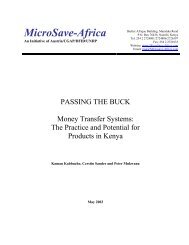You also want an ePaper? Increase the reach of your titles
YUMPU automatically turns print PDFs into web optimized ePapers that Google loves.
In the 1980s, after<br />
rapid growth and<br />
a string <strong>of</strong> veteran<br />
departures, <strong>DAI</strong><br />
struggled to foster<br />
good communication<br />
between Washington<br />
and the field.<br />
34<br />
<strong>of</strong> a telex or fax line, pick up loose ends, and<br />
direct callers and visitors to the right person in<br />
<strong>DAI</strong>. Martha Rawasia, later known as Martha<br />
Keller and Martha Fowler, was probably the<br />
only person who could have handled her three<br />
bosses so effortlessly while becoming a friend<br />
and confidante <strong>of</strong> everyone who worked at <strong>DAI</strong><br />
or crossed its threshold as a visitor. She moved<br />
out <strong>of</strong> town in 1985, and came back two <strong>years</strong><br />
later—after Barclay approached her on bended<br />
knee—and remained with <strong>DAI</strong> for almost 20<br />
more <strong>years</strong> after that.<br />
With a more expansive view <strong>of</strong> the market, more<br />
proposals to write, and more short-term consulting<br />
teams to be staffed, <strong>DAI</strong> augmented its<br />
recruiting capacity during the 1980s. A resilient<br />
team, all <strong>of</strong> whom had lived in West Africa in recent<br />
<strong>years</strong>, worked in the 9th Street <strong>of</strong>fice across<br />
the hall from Max Goldensohn. Heidi Lowenthal<br />
and Mary Jane Stickley became <strong>DAI</strong> institutions<br />
in their own right, juggling always-urgent-doit-now<br />
requests from Goldensohn with good<br />
humor and an uncanny ability to find the right<br />
people who could do the work “the <strong>DAI</strong> way.”<br />
Lowenthal’s successor, Sherie Valderrama,<br />
maintained this sharp focus on recruiting both<br />
talent and character, oversaw the design and<br />
installation <strong>of</strong> a computerized Recruitment Management<br />
System, and eventually was honored<br />
with the <strong>DAI</strong> Values Award in 1999.<br />
As a new generation came in, some in the older<br />
generation moved on. George Honadle, Elliott<br />
Morss, and Jerry Silverman all departed in the<br />
early 1980s, never having fully adjusted to what<br />
Honadle called “the dictates <strong>of</strong> organized evolution<br />
and survival.” At the end <strong>of</strong> the decade,<br />
veterans Ken Koehn and David Gow also left.<br />
A sad landmark <strong>of</strong> sorts was passed in 1988,<br />
when Tom Stickley, who with wife Mary Jane<br />
had served in West Africa, Haiti, and Indonesia,<br />
died <strong>of</strong> a lung infection and hepatitis—the first<br />
death in <strong>DAI</strong>’s extended family. Exotic illness<br />
also tripped up Charlie Sweet, who came home<br />
in 1982 from Tanzania under doctor’s orders,<br />
due to a lingering foodborne virus he had<br />
picked up in the field. Sweet’s health remained<br />
shaky for <strong>years</strong> to come, and he never rejoined<br />
<strong>DAI</strong>’s management team. He died in March<br />
2009, at the age <strong>of</strong> 66.



